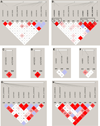Identification of fetal and maternal single nucleotide polymorphisms in candidate genes that predispose to spontaneous preterm labor with intact membranes
- PMID: 20452482
- PMCID: PMC3604889
- DOI: 10.1016/j.ajog.2010.03.026
Identification of fetal and maternal single nucleotide polymorphisms in candidate genes that predispose to spontaneous preterm labor with intact membranes
Abstract
Objective: The purpose of this study was to determine whether maternal/fetal single nucleotide polymorphisms (SNPs) in candidate genes are associated with spontaneous preterm labor/delivery.
Study design: A genetic association study was conducted in 223 mothers and 179 fetuses (preterm labor with intact membranes who delivered <37 weeks of gestation [preterm birth (PTB)]), and 599 mothers and 628 fetuses (normal pregnancy); 190 candidate genes and 775 SNPs were studied. Single locus/haplotype association analyses were performed; the false discovery rate was used to correct for multiple testing.
Results: The strongest single locus associations with PTB were interleukin-6 receptor 1 (fetus; P=.000148) and tissue inhibitor of metalloproteinase 2 (mother; P=.000197), which remained significant after correction for multiple comparisons. Global haplotype analysis indicated an association between a fetal DNA variant in insulin-like growth factor F2 and maternal alpha 3 type IV collagen isoform 1 (global, P=.004 and .007, respectively).
Conclusion: An SNP involved in controlling fetal inflammation (interleukin-6 receptor 1) and DNA variants in maternal genes encoding for proteins involved in extracellular matrix metabolism approximately doubled the risk of PTB.
Figures







Comment in
-
Preterm birth is the leading cause of neonatal mortality and is responsible for roughly one-half of long-term neurologic sequelae.Am J Obstet Gynecol. 2010 May;202(5):407-8. doi: 10.1016/j.ajog.2010.03.027. Am J Obstet Gynecol. 2010. PMID: 20452479 No abstract available.
References
-
- McCormick MC. The contribution of low birth weight to infant mortality and childhood morbidity. N.Engl.J.Med. 1985;312:82–90. - PubMed
-
- Slattery MM, Morrison JJ. Preterm delivery. Lancet. 2002;360:1489–1497. - PubMed
-
- Biggio J, Christiaens I, Katz M, Menon R, Merialdi M, Morken NH, et al. A call for an international consortium on the genetics of preterm birth. Am J Obstet.Gynecol. 2008;199:95–97. - PubMed
-
- Chaudhari BP, Plunkett J, Ratajczak CK, Shen TT, DeFranco EA, Muglia LJ. The genetics of birth timing: insights into a fundamental component of human development. Clin.Genet. 2008;74:493–501. - PubMed
Publication types
MeSH terms
Substances
Grants and funding
LinkOut - more resources
Full Text Sources
Other Literature Sources
Medical
Research Materials
Miscellaneous

